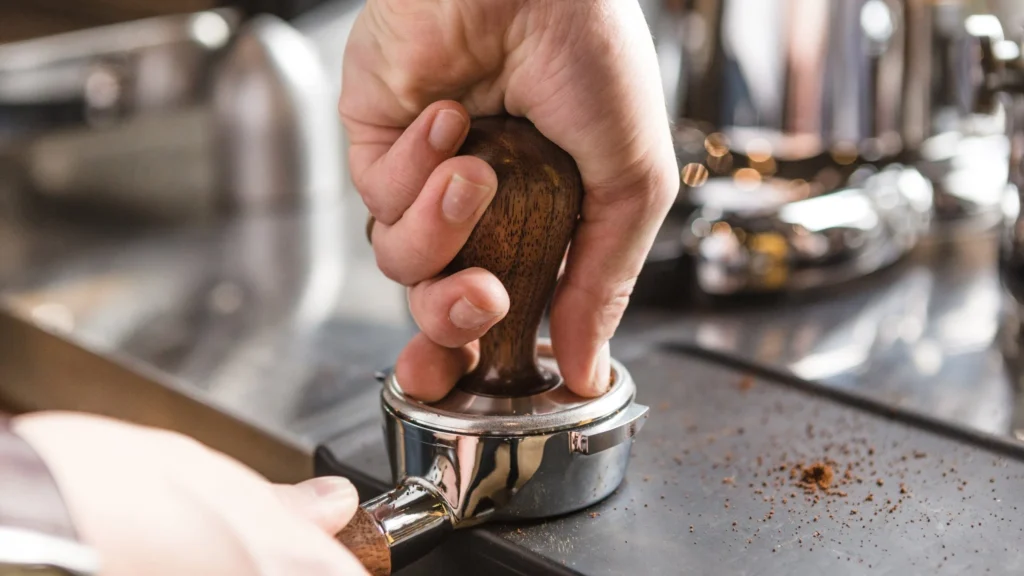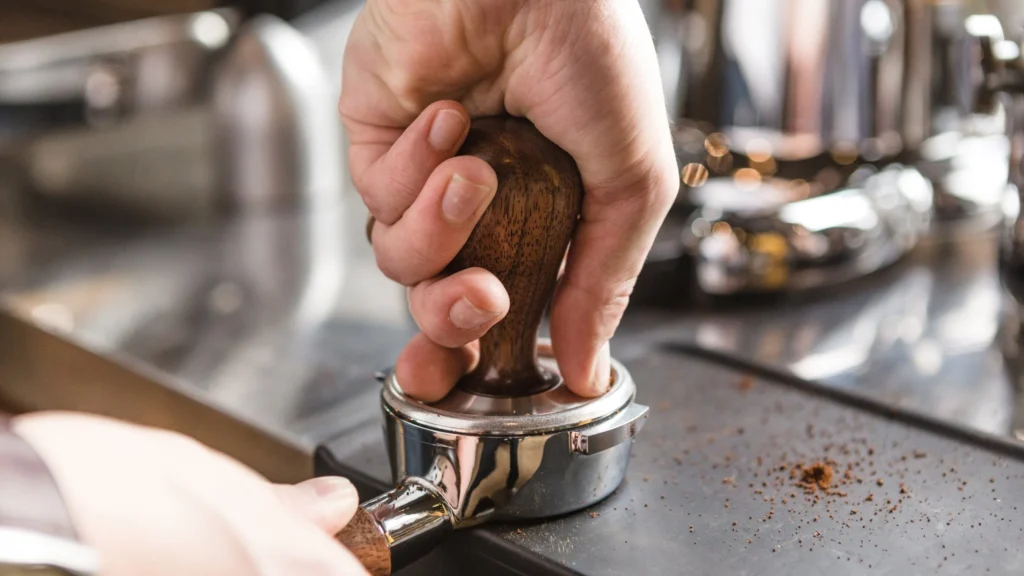Hey there, coffee lovers! If you’re aiming to brew the perfect espresso, you know that every step counts. One of the most crucial steps that often gets overlooked is the espresso tamp, which creates the espresso puck. This seemingly simple act of compressing coffee grounds in your portafilter can make a world of difference in the flavor and quality of your shot.
Tamping is all about creating an even, compact coffee puck that allows water to flow through at a consistent rate, ensuring optimal extraction. Get it right, and you’re on your way to a rich, balanced espresso. Get it wrong, and you might end up with a bitter, uneven mess.
Using a distribution tool can help ensure that the coffee grounds are spread evenly before tamping, which is crucial for achieving a consistent extraction.
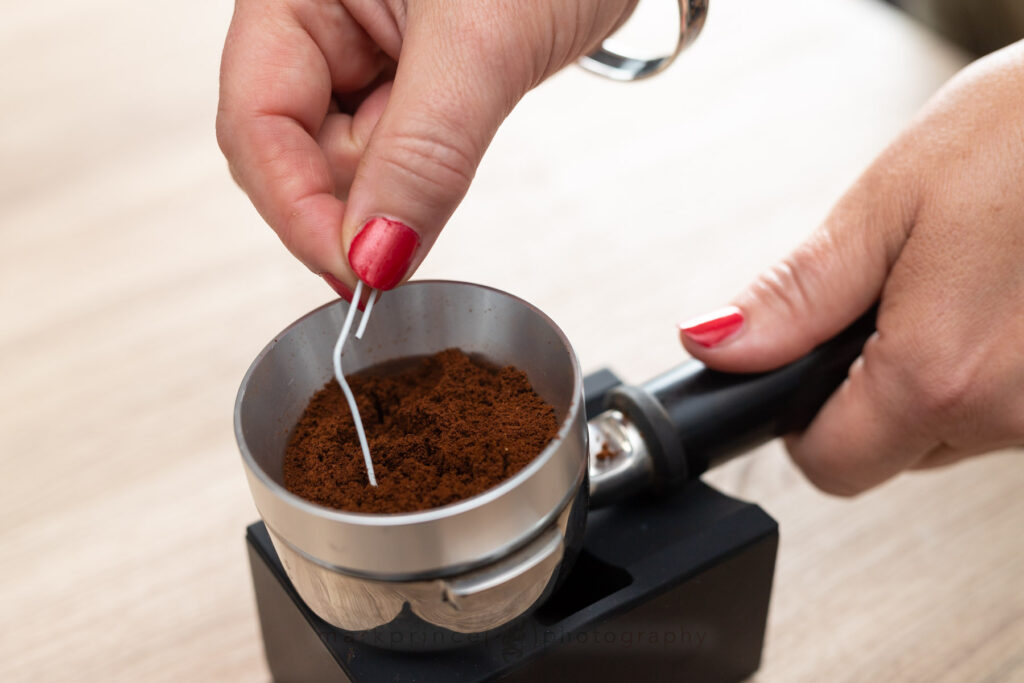
In this guide, we’ll break down the essentials and the art of tamping espresso grounds, from choosing the right tools to nailing the perfect technique. Whether you’re a home barista just starting out or a seasoned pro looking to refine your skills, mastering tamping is a game-changer. So grab your tamper, and let’s dive into the art of perfecting your espresso!
Understanding Tamping and Its Influence on Espresso Flavor
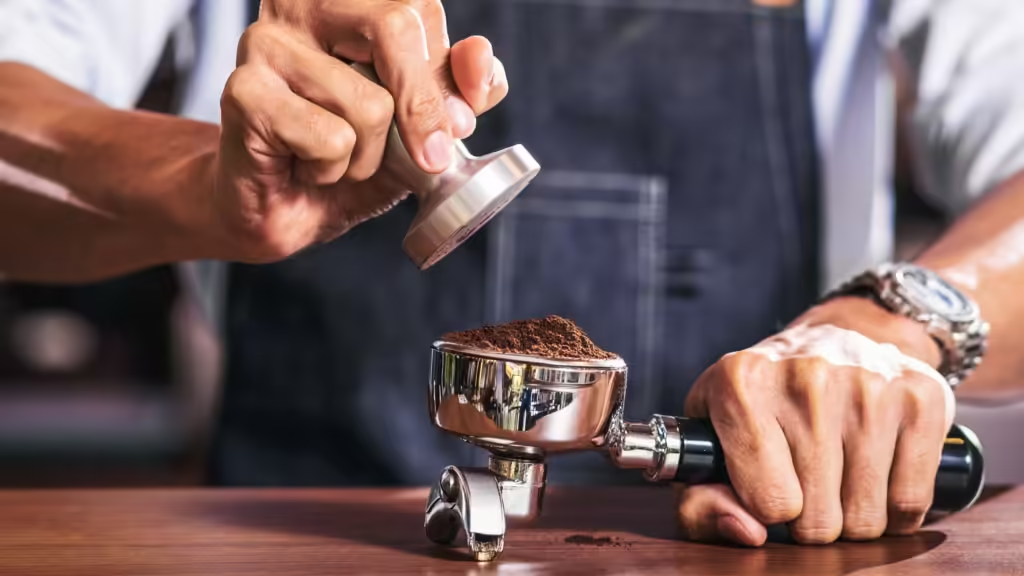
Tamping is a crucial step in the espresso brewing process that involves compressing ground coffee into the portafilter basket to ensure even extraction. Proper tamping technique is essential to achieve a well-balanced espresso shot.
When you tamp espresso, you’re not just pressing down on the coffee grounds; you’re setting the stage for the entire brewing process. The goal is to create a compact, level puck of coffee that allows water to flow through at a consistent rate. This consistency is key to extracting the full range of flavors from the coffee grounds, resulting in a rich, balanced espresso.
The process begins with placing the ground coffee into the portafilter basket. It’s important to distribute the coffee evenly before tamping to avoid any weak spots that could lead to channeling. Once the coffee is evenly distributed, use a tamper to apply even pressure, compressing the grounds into a solid puck.
The ideal tamping pressure is around 30 pounds, but the most important aspect is consistency. A uniform tamp ensures that the water flows through the coffee evenly, extracting all the delicious flavors and oils.
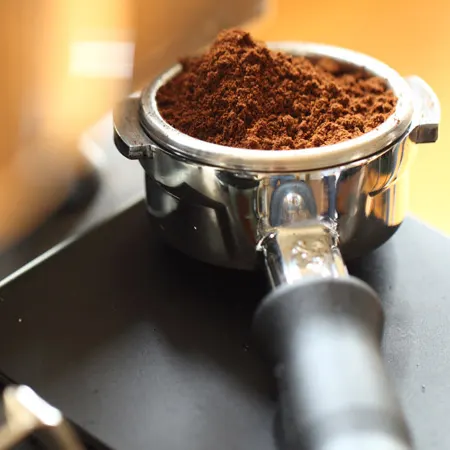
By mastering the art of tamping, you can significantly improve the quality of your espresso shots. Proper tamping helps prevent issues like uneven extraction, which can lead to bitter or sour flavors. Instead, you’ll achieve a smooth, well-balanced espresso that highlights the best characteristics of your coffee beans. So, take the time to perfect your tamping technique, and you’ll be rewarded with consistently excellent espresso shots.
What is Espresso Tamping?
Alright, let’s break it down in simple terms. Espresso tamping is the process of compressing ground coffee into a compact puck inside the portafilter basket before brewing espresso, and mastering the right tamping technique is crucial for ensuring that your espresso shot is balanced, flavorful, and extracted evenly.
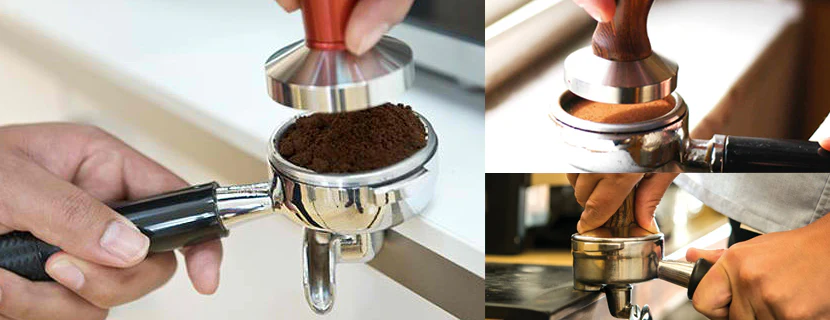
A stirring tamp can also be used to ensure that the coffee grounds are evenly distributed before tamping.
Here’s why tamping is essential:
Even Extraction: When you tamp the coffee grounds evenly, it creates a uniform surface. This ensures that the water flows through the coffee at an even rate, extracting all those delicious flavors evenly.
Resistance to Water Flow: Proper tamping provides the right amount of resistance for the water as it passes through the coffee grounds. This helps in building the pressure needed to brew a rich, creamy espresso shot.
Consistency: Tamping the coffee grounds consistently each time you brew helps in maintaining the quality of your espresso shots. It’s all about getting that perfect balance every time.
Why Tamping Matters
When you skip proper tamping or do it incorrectly, the water can find channels through the less compacted parts of the coffee puck. This leads to uneven extraction – some parts of the coffee may be over-extracted (bitter), while others may be under-extracted (sour or weak).
Proper tamping ensures that all the coffee grounds contribute to the flavor of the espresso, resulting in a balanced and delicious shot, and consistent tamping pressure is key to achieving this. Using a calibrated tamper can help ensure that you apply the optimal tamping pressure consistently.
Preparing for Tamping
Before you start tamping, it’s essential to prepare your equipment and workspace. Ensure your espresso machine is clean and in good working condition. A clean machine prevents any old coffee residues from affecting the taste of your fresh brew. Using a distribution tool can help ensure that the coffee grounds are spread evenly before tamping. Choose a high-quality coffee bean that is freshly roasted and grind it to the optimal fineness for espresso brewing. Freshly ground coffee is key to achieving the best flavor and aroma.
Measure the coffee grounds using a scale to achieve the standard dose of 18-20 grams for a double shot. Precision in this step ensures consistency and predictability in your results. Place the measured coffee in the portafilter basket and run your index finger over the top to remove any excess grounds. This helps to create a level surface, which is crucial for even tamping and extraction. By taking these preparatory steps, you set the stage for a perfect espresso shot.
The Tamping Process
The tamping process is a crucial step in espresso brewing that involves compressing ground coffee into a puck shape to ensure even extraction. To achieve this, a tamper is used to apply pressure to the coffee grounds in the portafilter basket.
Tamping begins with placing the ground coffee into the portafilter basket. It’s essential to distribute the coffee grounds evenly to avoid any weak spots that could lead to channeling. Once the coffee is evenly distributed, use a tamper to apply even pressure, compressing the grounds into a solid puck shape. The goal is to create a compact, level puck that allows water to flow through at a consistent rate, extracting the full range of flavors from the coffee grounds.
The ideal tamping pressure is around 30 pounds, but consistency is more important than the exact amount of pressure. A uniform tamp ensures that the water flows through the coffee evenly, extracting all the delicious flavors and oils. After tamping, give the tamper a slight twist to polish the surface of the coffee puck, ensuring that any loose grounds are compacted and won’t interfere with the extraction.
By mastering the tamping process, you can significantly improve the quality of your espresso shots. Proper tamping helps prevent issues like uneven extraction, which can lead to bitter or sour flavors. Instead, you’ll achieve a smooth, well-balanced espresso that highlights the best characteristics of your coffee beans. So, take the time to perfect your tamping technique, and you’ll be rewarded with consistently excellent espresso shots.
How to Master the Art of Tamping: Step-by-Step
Gather Your Tools: Portafilter Basket

To begin your journey towards the perfect espresso, it’s crucial to start with the right tools. Freshly ground coffee is essential for the best flavor; using pre-ground coffee can result in a stale or lackluster shot.
Ensure your portafilter is clean and dry to avoid any contamination or water interference that could affect the extraction. The tamper should fit snugly within your portafilter basket; a mismatch can lead to uneven pressure and poor extraction.
Lastly, a scale is indispensable for measuring your coffee accurately. Consistency in dosing is key to achieving a uniform and balanced espresso shot, so never skip this step. A distribution tool can also be helpful in ensuring that the coffee grounds are spread evenly before tamping.
Dose and Distribute

Next, measure out the correct amount of coffee. Typically, for a double shot, you’ll need about 18-20 grams. Precision in this step ensures consistency and predictability in your results. Evenly distribute the coffee grounds in the portafilter.
You can use your finger or a specialized distribution tool to spread the grounds evenly. This step is crucial as it helps prevent channeling, where water finds weak spots and flows through unevenly, leading to an imbalanced extraction.
Proper distribution sets the stage for an even tamp and a well-balanced espresso. The first tamp is essential in this process, as applying light and even pressure ensures the coffee grounds are compacted uniformly, creating a properly shaped puck for optimal extraction during brewing.
Tamp with Even Tamping Pressure

Now, it’s time to tamp. Grip the tamper like a doorknob, with your elbow at a 90-degree angle for optimal control and leverage. Press down evenly with approximately 30 pounds of tamping pressure. The goal is to create a level, compact puck shape of coffee grounds.
This puck shape is crucial as it ensures that the water will flow through the coffee evenly, extracting all the flavors uniformly. Avoid pressing too hard, as excessive pressure can damage the portafilter basket and lead to over-extraction, which can make the espresso taste bitter.
Polish the Surface

After you’ve tamped, give the tamper a slight twist. Using a tamping mat can provide a stable surface and prevent the portafilter from slipping during this step. This polishing step helps to smooth out the surface of the coffee puck, ensuring that any loose grounds are compacted and won’t interfere with the extraction.
A polished surface promotes even water distribution during the brewing process, which is vital for a balanced shot. This small step can make a significant difference in the final taste of your espresso, enhancing its smoothness and complexity.
Check for Uniformity

Finally, inspect the tamped coffee puck. A distribution tool can help ensure that the coffee grounds are spread evenly before tamping. The surface should be smooth and flat. If you notice any unevenness or gaps, adjust as needed. A uniform bed of coffee is crucial for consistent extraction. Even small irregularities can lead to channeling, where water bypasses certain areas of the coffee, resulting in an uneven extraction and a less flavorful shot. By ensuring that the coffee is evenly tamped and level, you can achieve a perfect extraction every time.
Mastering these steps will greatly improve the quality of your espresso shots, making them richer and more balanced. Each part of the process, from gathering your tools to checking for uniformity, plays a vital role in achieving the perfect espresso. With practice and attention to detail, you’ll find that your tamping technique becomes second nature, leading to consistently excellent results.
The Importance of Even Extraction
Even extraction is crucial for achieving a perfect shot of espresso. When the coffee grounds are not evenly compacted, it can lead to channeling, where the water flows through the coffee too quickly, resulting in an under-extracted shot. Under-extraction can make your espresso taste sour or weak, as the water hasn’t had enough contact time with the coffee grounds to extract the full range of flavors.
On the other hand, if the coffee is over-extracted, it can lead to a bitter taste. Over-extraction occurs when the water flows too slowly through the coffee grounds, pulling out undesirable flavors. Even extraction ensures that the water flows through the coffee grounds at the optimal rate, extracting the desired flavors and oils. To achieve even extraction, it’s essential to tamp the coffee grounds evenly and consistently with the right tamping pressure. This balance is what gives your espresso its rich, complex flavor.
Tools That Improve Tamping Consistency
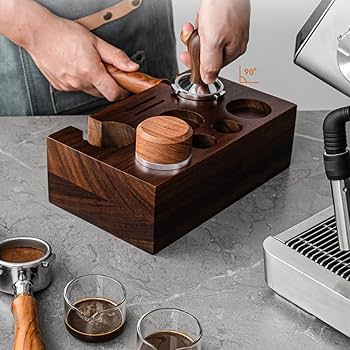
To tamp espresso like a pro, you’ll need the right tools and accessories. A high-quality tamper is essential for compressing the coffee grounds evenly. Look for a tamper that is made from a durable material, such as stainless steel or aluminum, and has a comfortable handle. The right tamper will help you apply consistent pressure, which is crucial for even extraction.
A calibrated tamper can help ensure that you apply the optimal tamping pressure consistently.
Distribution Tools (WDT, Levelers) this tool is used to break clumps and distribute grounds evenly before tamping. Helps minimize channeling.
A tamping mat is also recommended to prevent the portafilter from slipping or moving during the tamping process. This not only protects your countertop but also ensures stability, allowing you to tamp with confidence.
Other accessories, such as a distribution tool or stirring tamp, can help to distribute the coffee grounds evenly before tamping.
These tools ensure that the coffee is tamped evenly, leading to a smooth, even extraction and a more balanced espresso shot.
Common Mistakes to Avoid
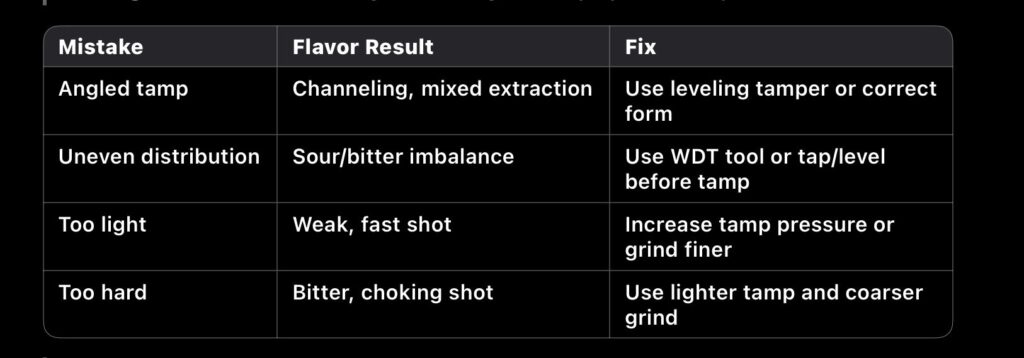
- Mistake Flavor Result Fix
- Angled tamp Channeling, mixed extraction Use leveling tamper or correct form
- Uneven distribution Sour/bitter imbalance Use WDT tool or tap/level before tamp
- Too light Weak, fast shot Increase tamp pressure or grind finer
- Too hard Bitter, choking shot Use lighter tamp and coarser grind
Tips for Mastery
Experiment with Pressure: Different coffee blends might require slight adjustments in tamping pressure. Experiment to find what works best for your specific beans.
Consistency is Key: Use the same amount of coffee, apply even pressure, and maintain a level surface each time to achieve consistent results.
Use a Calibrated Tamper: Use a calibrated tamper to ensure that you apply the optimal tamping pressure consistently.
Practice Proper Technique: Position your body for stability and control during tamping. Regular practice will help you develop muscle memory for applying consistent pressure.
Troubleshooting Common Tamping Issues
Even with the right tools and techniques, tamping issues can still arise. Here are some common issues and how to troubleshoot them:

Uneven extraction: Check that the coffee grounds are evenly distributed in the portafilter basket. Use a distribution tool or stirring tamp to mix and even out the grounds. This helps prevent channeling and ensures a balanced extraction.
Loose grounds: Ensure that the portafilter is securely locked into place and that the coffee grounds are not too fine or too coarse. Loose grounds can lead to an uneven extraction and a weak shot.
Excess grounds: Make sure the portafilter is not overfilled and that the coffee grounds are not spilling over the edges. Excess grounds can cause an uneven tamp and affect the extraction.
Tamping pressure: Ensure that the tamping pressure is consistent and even. Use a calibrated tamper to ensure the optimal pressure, typically around 30 pounds. Inconsistent pressure can lead to an uneven extraction and affect the flavor of your espresso.
By addressing these common issues, you can improve your tamping technique and achieve a more consistent and flavorful espresso shot.
Advanced Tamping Techniques
Once you’ve mastered the basics of tamping, you can experiment with advanced techniques to take your espresso game to the next level. Using a distribution tool can help ensure that the coffee grounds are spread evenly before tamping, which is crucial for advanced techniques. Here are a few techniques to try:
Nutation: This technique involves rotating and angling the tamper through 360° in the filter basket to achieve an even tamp. This can help to create a more even extraction and a smoother flavor.
Staub tamp: This technique involves tamping squarely, then tamping at the corners of the filter basket to push down on loose coffee. This can help to create a more even extraction and prevent channeling.
Tamping with a twisting motion: This technique involves twisting the tamper as you apply pressure to create a smooth, even finish to the compacted puck of coffee. This can help to create a more even extraction and a smoother flavor.
By experimenting with these advanced techniques, you can refine your tamping skills and achieve a more consistent and flavorful espresso shot.
Conclusion
Tamping might seem like a simple press, but it plays a powerful role in how your espresso tastes. From distribution to leveling and pressure control, every step affects the flow and flavor.
Whether you’re a home barista or running a café, dialing in your tamping technique leads to more consistent, more delicious espresso—shot after shot.
Our blog contains affiliate links to products. We may receive a commission for purchases made through these links. However, this does not impact our reviews and comparisons. We try our best to keep things fair and balanced, in order to help you make the best choice for you.

